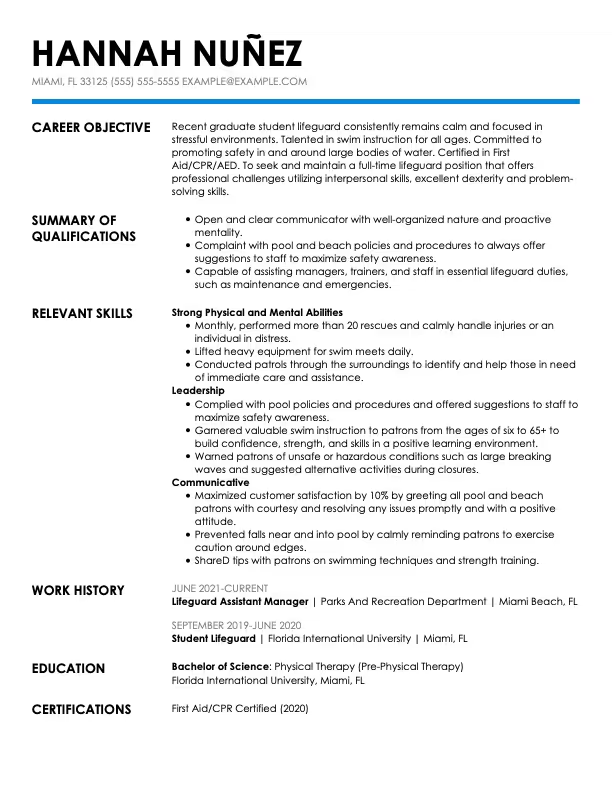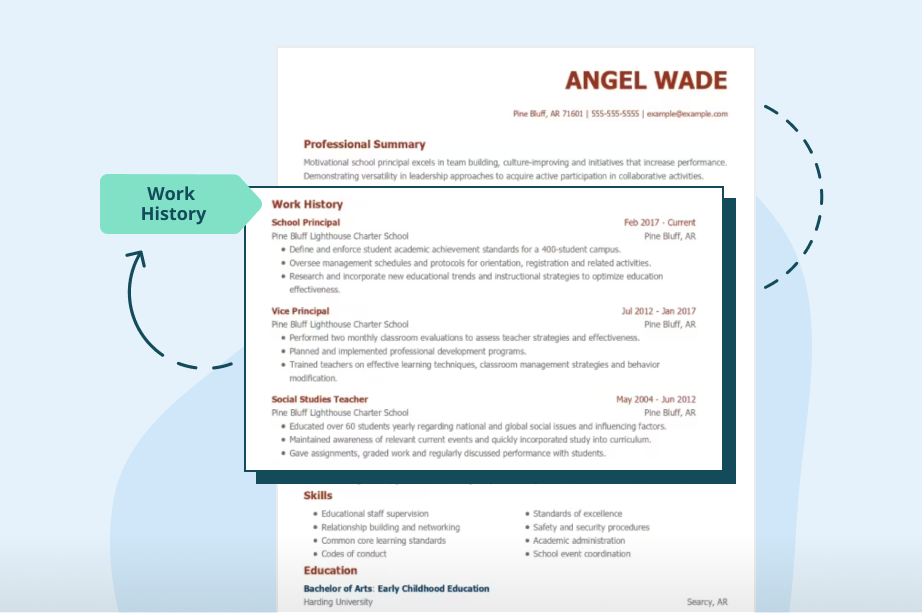The functional resume format is also known as a skills-based resume. This flexible, customizable layout works best for career changes, work gaps, freelancers and first time job seekers. Read our helpful guide and functional resume samples to prepare for your job search.
Want a stronger resume? Try our resume templates. Simply edit and download. Plus, you’ll get ready-made content to add with one click using our Resume Builder.
Or view our sample resumes made with our professional templates.
What is a Functional Resume?
The functional resume is a skills-based resume that downplays your work history. You may ask, “what does a functional resume highlight?” A functional resume can highlight your skills, match them to the job posting and increase the chances of getting an interview, even without the required experience. This format allows you to market your knowledge and downplay potential red flags like a lack of formal expertise or career gaps.
A functional resume features the following resume sections:
- Contact information
- Resume summary
- Summary of qualifications
- Professional skills
- (OPTIONAL) Additional skills
- Work history
- Education
PRO TIP:
The functional resume places your formal work experience toward the bottom of the page and emphasizes your technical skills and abilities. Instead of starting with career highlights, a functional resume format allows you to explain how your career goals align with the position to which you are applying.
Recommendation letter format tips
A functional resume features multiple detailed skills sections.

- 1
- 2
- 3
- 4
- 5
- 6
Contact information
- A standard section at the top of a resume includes your name, number, email and location.
Resume summary
- A three-sentence introduction to persuade recruiters to read your resume.
Summary of qualifications
- Add three to four significant accomplishments related to job-specific skills.
Professional skills
- Add multiple sections based on specific skill types like language, technical, programming or computer skills.
Work history
- This simplified section lists previous job titles, employers and years of employment.
Education
- This short section includes job-relevant degrees or certifications and dates of completion.
Who Should Use a Functional Resume?
Although the functional resume offers a professional strategy to share your skills and accomplishments, the customizable aspects of the format make it a risky choice for most job seekers. You should only use the functional resume if you fall under the following criteria.
- Recent graduates.
- Changing careers.
- Freelancers.
- Have less than three years of experience in the industry.
- Have gaps or many different jobs throughout their work history.
- Reentering the workforce after a long absence.
- Spent less than one year at two or more jobs.
- Have a direct referral connection to an open job.
- If you have over three years of experience.
- Have little to no work gaps between jobs.
- Followed a direct career path.
- Wish to highlight promotions or career growth.
Try a different resume format
If you have 10 years or more of experience, try the chronological format. This resume format puts the greatest focus on your work experience, starting with the most recent job, and gives recruiters a clear overview of your top achievements.
Use a hybrid/combination resume if you have between three and nine years of experience. This type of resume combines the best of the chronological and functional formats, and promotes your expertise and skills.
These two formats are safer because they use five standard resume sections that are recruiter and ATS-friendly (applicant tracking systems.)
9 Functional Resume Examples
Functional Resume Template
[with Tips]
[Your Name]
[Your Address]
[City, State ZIP Code]
[Your Email Address]
[Your Phone Number]
[LinkedIn Profile URL]
Resume Summary
[Insert your summary here. This should be a brief statement highlighting your core qualifications and career goals.]
Summary of Qualifications
- [Insert qualification #1]
- [Insert qualification #2]
- [Insert qualification #3]
- [Insert qualification #4]
[Type of] Skills
- [Add relevant accomplishment or responsibility related to Skill 1]
- [Add relevant accomplishment or responsibility related to Skill 1]
- [Add relevant accomplishment or responsibility related to Skill 1]
- [Add relevant accomplishment or responsibility related to Skill 1]
[Type of] Skills
- [Add relevant accomplishment or responsibility related to Skill 2]
- [Add relevant accomplishment or responsibility related to Skill 2]
- [Add relevant accomplishment or responsibility related to Skill 2]
- [Add relevant accomplishment or responsibility related to Skill 2]
[Type of] Skills
- [Add relevant accomplishment or responsibility related to Skill 3]
- [Add relevant accomplishment or responsibility related to Skill 3]
- [Add relevant accomplishment or responsibility related to Skill 3]
- [Add relevant accomplishment or responsibility related to Skill 3]
Work History
[Job Title #1] | [Company Name #1]
[Location], [Year]
[Job Title #2] | [Company Name #2]
[Location], [Year]
Education
[Degree Earned]
[University/College Name], [Location]
[Graduation Date]
- [OPTIONAL: Add relevant coursework or academic achievements]
- [OPTIONAL: Add any honors or awards received]
Functional Resume FAQ
What does a functional resume highlight?
A functional resume highlights a job seeker's specific skills, qualifications and achievements rather than emphasizing their chronological work history. The functional format is structured to showcase relevant competencies, making it an effective choice for those with employment gaps or career-changers. This format helps employers quickly identify applicants' abilities and suitability for the job.
Visit our suggested words to describe yourself to help persuade hiring managers.
Who is a functional resume best for?
This format is best for job seekers with:
- Non-linear career paths
- Employment gaps
- Career changers
- Recent graduates
- Entry level
- Re-entering the workforce
Visit our no-experience resumes to learn how to create a job-winning resume — even without experience.
Why is a functional resume format best for students and teenagers?
Because this is a skill-based resume, the functional format works best when you have almost no work experience. It's ideal for students and teenagers because they are new to the job market.
Although a recent graduate may have little to no formal experience, the functional resume helps you highlight job-transferable skills. You can also use the functional resume to highlight academic accomplishments like extracurricular activities, volunteer work and certifications.
You can visit our high school resume templates to see how recent graduates describe themselves.
Why is a functional resume good for people with a gap since their last job?
The functional format deliberately adds more information about your responsibilities and achievements under skills-based sections to draw attention away from your work history. Because if it puts less emphasis on dates of employment and prioritizes your qualifications, this helps you prove yourself as a well-trained candidate.
Why avoid a functional resume?
Avoid a functional resume if you have a straightforward career history — hiring managers know that candidates use this to downplay work gaps.
Functional resumes can also be less effective in industries where a detailed work history is essential, such as senior or leadership positions, as they downplay past job titles and make it hard for employers to track your career growth.












